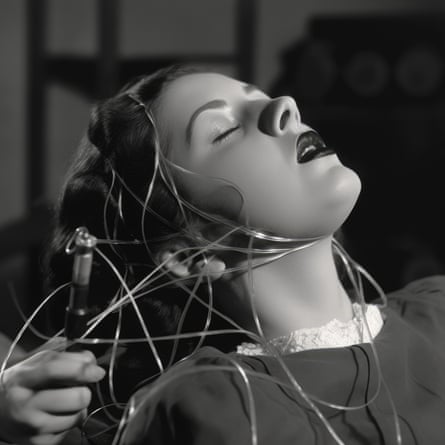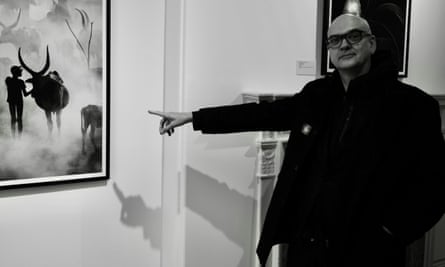Since 52-year-old German artist Boris Eldagsen went public with the fact that he won a Sony world photography award with an AI-generated image, relations between him and the award body have soured. Sony have issued a statement, saying: “We no longer feel we are able to engage in a meaningful and constructive dialogue with him.” His website reads: “Sony: Stop saying nonsense!”
“I don’t know why they behaved like this,” he says, speaking to me from Berlin on the morning after the controversy broke. But I have a fair idea: plainly, they feel like they were conned, and had their aesthetic discernment called into question. If you can’t tell the difference between a photograph and an AI-generated image, then you may as well go home. But maybe both parties are being both too hard and too easy on themselves. Maybe, when done well enough, AI images can’t be distinguished from photography by anybody. And yet, as Eldagsen says, “I love photography, I love generating images with AI, but I’ve realised, they’re not the same. One is writing with light, one is writing with prompts. They are connected, the visual language was learned from photography, but now AI has a life of its own. If people want to be silent and not talk about that, that’s wrong.”
Eldagsen grew up in south-west Germany: “low culture, forest, medieval castles, Roman leftovers, very close to the French border. If that’s fine for you, it’s great to stay there. If you’re looking for art and culture, you have to leave, as I did when I was 20.” He studied philosophy at university in Cologne, then photography and fine art in Mainz, and after that, he tells his life through a succession of love affairs: the girlfriend who persuaded him to study for a term in Hyderabad, in India; the Australian artist who got him to move to Australia; the psychologist partner who diagnosed his ADHD, which he says explains his hyperfocus: “If you love what you do, you are more efficient than a non-ADHD person.”
He’s a one-off, a roamer, he conceives countries as people: “It’s always strange, if you’ve lived in Australia, to spend time in the UK. It’s like you had a relationship with the daughter and now you come and spend time with mum.” He says the only way to make British people laugh is by talking about Nazis, which Germans have trained themselves not to do. I tell him he doesn’t have to talk about any Nazis.
HIs work was always conceptual rather than figurative, long before he started working with AI. “My approach to photography was psychological and philosophical. It was a journey inside; it was not depicting what everybody sees in front of them. Having that background, AI fascinated me. It was built from the collective unconscious. I also saw that the way it works can be related to Plato’s theory of ideas [also known as the theory of forms].” OK, it may help here to consider the image, and how it was made. Or it may not help. Let’s give it a shot.

It’s a black-and-white portrait of two women, the older one behind with her hands, weathered to the point of being misshapen, on the younger woman’s shoulders. It may be a wedding day – that is suggested as much in the interplay of trepidation and disillusionment in the four watchful eyes as it is in the subtle finery of the maybe-bride’s white dress. The image is called The Electrician, from the series Pseudomnesia, another term for false memory – which could have been a breadcrumb trail for the judges, but never mind them.
It’s an immensely evocative scene, conjuring so much about the human condition and its timelessness – hell, that’s probably why it won in the first place. But that’s also why it is so unsettling that a machine made it.
Except a human was involved, of course. “The process has many steps, it’s not putting in three words and clicking ‘generate’,” Eldagsen explains. “I identified 11 parts of the prompt; you create an image with text prompt, then when you want to leave the frame, do something to the image outside of the painting [for example, create imperfections to the surface, as there are on The Electrician], then again you have to describe, ‘What do I want to appear?’” His adventures in AI haven’t given him an identity crisis as a photographer, because he was never in love with the idea of a single, unified author in the first place. “It was always a collaboration. I’ve been working in teams with artist friends for 25 years.”

And he emphatically doesn’t see the process of building an AI image as dehumanised, or even one in which the human is sidelined. “I don’t see it as a threat to creativity. For me, it really is setting me free. All the boundaries I had in the past – material boundaries, budgets – no longer matter. And for the first time in history, the older generation has an advantage, because AI is a knowledge accelerator. Two thirds of the prompts are only good if you have knowledge and skills, when you know how photography works, when you know art history. This is something that a 20-year-old can’t do.”
Where Plato comes in is that his theory of forms – that there’s an ideal version of, for instance, a table, and every real-life iteration of a table is merely an imitation, a version of the original idea – is outsourced to the algorithm, which stores all the iterations, holds the knowledge of our collective unconscious. Eldagsen says, “Many people, when they complain about AI, say it’s copying and stealing. It’s not, it’s learning the Platonic theory.”
after newsletter promotion
The real challenge presented by AI is not that it might rock our attachment to human creativity as somehow unique and unfathomable – though who likes it when that happens? – nor even that it may destroy jobs and, potentially, whole industries – though that’s not great either. “The threat,” Eldagsen says, “is to democracy and to photojournalism; we have so many fake images, we need to come up with a way to show people what is what.”

You might think you’re all over fake news, but the tech has moved faster than the conversation. Mick Gordon, studying for a PhD in AI at Queen Mary’s in Belfast, explains: “Rudimentary AI is specific pattern recognition. It’s really tricky, and it still has hallucinations, or struggles to recognise the difference between a dog and a cat. The panic is, ultimately, you’re going to have truth, and you’re going to have reality, and reality’s going to be a mixture of truth, hallucinations – that’s what they call it when the machine does something weird – and deliberate non-truth. Propaganda used to deliver a singular message to the exclusion of other messaging. Now propaganda will just deluge you with everything.” The question isn’t, “Who made this art, a human or machine?” or “Can machine-art be real?” It’s more fundamental: how much truth is there in my reality? Or maybe those are all the same question; Plato would know.
Eldagsen suggests, in the first instance, a sort-of traffic light system, AMG, where news images are labelled “authentic, manipulated or generated. The facts take so much time, so many people. We need to have a structure to support the press, they can’t do it on their own.” But this is part of a much larger conversation about forcing distinctions between photography and AI-generated images. Giving it a name would be a start: “promptography” is Eldagsen’s suggestion. “It’s complex,” he says, “and because it’s complex, it needs a discussion. [My image] was shared so many times that it’s reaching the press and I’m very happy about that. Mission accomplished. I’m happy to play my part.”

